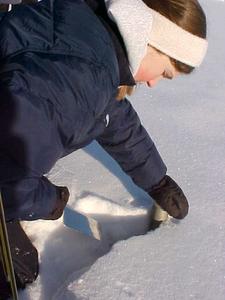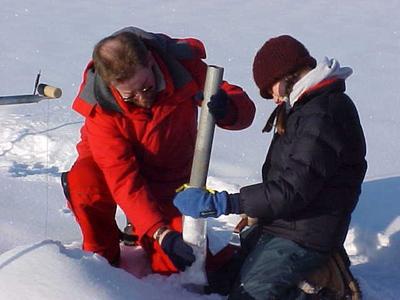
|
17 February, 2003INSOLATION vs. INSULATION It was a wonderful, bright afternoon at Aurora Pond. We donned our sunglasses and marched across the ice surface to the spot where Dr. Jeffries and a local home-school group had established transect lines. The temperature had warmed from a bone chilling -35 degrees C to a balmy -12 degrees C. So sunny, yet so darned cold! How could this be? Insolation (quite different from yesterday's topic of insulation) refers to the intensity and duration of solar radiation. The amount of electromagnetic energy striking the earth at any given location is primarily determined by the change in position of Earth's axis in relation to the sun. As the position changes throughout the year, the angle of the sun in the sky changes by 47 degrees. The angle at which incoming solar radiation strikes the earth's surface will determine the intensity of insolation. When light strikes at smaller angles, light rays will be spread over a larger surface, lowering the overall intensity. This can be deceiving when the surface is highly reflective due to snow or ice cover. Intensity is a function of the angle of incidence and can therefore be calculated using this formula: Intensity = sin (A) In which A is the angle of incidence For example, the intensity of light hitting the surface at a 90-degree angle (which would be the most direct light that we could receive) would be the sine of 90, which is 1.00. If we multiply by 100 we determine the insolation would be 100% intensity. Use the sine function on your calculator to determine the intensity of insolation striking the earth's surface at the following angles (multiply answers by 100 to get percent): 80 degrees 70 degrees 60 degrees 50 degrees 40 degrees 30 degrees 20 degrees 10 degrees 0 degrees The units of energy associated with insolation levels in the United States are Kilowatt-hours per square meter per day. Visit the following Web site to find the monthly insolation values (data courtesy NASA) for your region. Try graphing the data, using months as your independent variable and KWh/m2/day as the dependent variable. (Obviously insolation DEPENDS on the month.) Go to http://www.focus-solar.com/insolation.htm and click on USA Insolation Levels.
Contact the TEA in the field at . If you cannot connect through your browser, copy the TEA's e-mail address in the "To:" line of your favorite e-mail package. |








